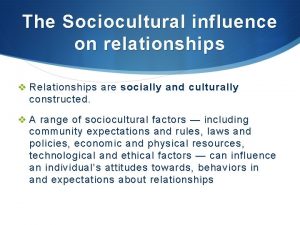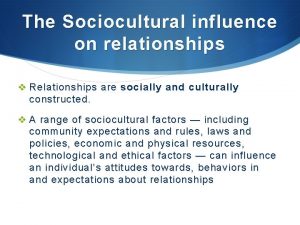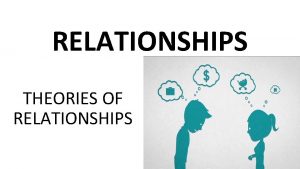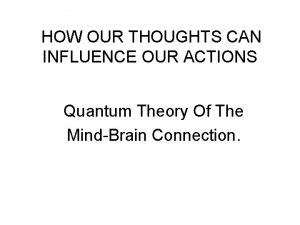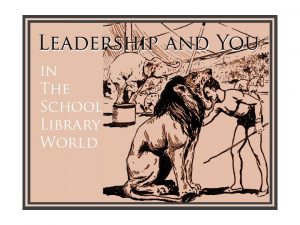The influence of relationships All of our relationships















- Slides: 15



The influence of relationships All of our relationships influence and shape how we grow, or do not grow, to be the person God created us to be. All of our experiences can influence, both positively and negatively, how we choose to relate to God. Which of your relationships are the most lifegiving for you, and why?

Holy Trinity (Triune God) God has revealed himself to be a Triune God: one God in three divine Persons: Father, Son and Holy Spirit. The Trinity is the central mystery of Christian faith and life. Faith in the Trinity shapes and influences everything we Christians believe and how we live.

The Revelation of the Trinity God revealed himself to us most fully by sending his Son, Jesus revealed that he and the Father and the Holy Spirit are distinct but inseparable Persons. There have been many efforts made to explain the mystery of the Trinity. For example, St. Patrick used the analogy of the shamrock―three leaves, one stem, yet all one shamrock. St. Augustine of Hippo spoke of ‘The Lover, the Beloved, and the Love Between’.

The development of the dogma of the Trinity The language expressing the Church’s faith in the Trinity emerged over time. The early Ecumenical Councils of the Church addressed this responsibility. Council of Nicaea I (325): Affirmed the full divinity of Jesus is ‘consubstantial with the Father’, meaning ‘of the same substance’ as the Father. Council of Constantinople I (381): Officially declared the teachings of Arius, which denied the divinity of Jesus, to be a heresy. Council of Chalcedon (451): Taught that Jesus is ‘consubstantial with the Father as to his divinity and consubstantial with us as to his humanity’.

The development of the dogma of the Trinity Council of Toledo (675): Reaffirmed the Holy Spirit’s relationship to the Father and the Son, and reaffirmed the Church’s faith in the divinity of the Holy Spirit. Councils of Lyons (1274) and Florence (1442): The Church confessed and reaffirmed her faith in the Trinity: there is one God in three divine Persons. This is the same faith that we profess today.

The search for language to describe the Trinity St. Augustine wrote: ‘If you understood him, it would not be God. ’ We can only speak of God by way of analogy. Analogy expresses truths that cannot be fully expressed in human language. For example, St. Patrick’s used the analogy of the shamrock to help people understand the relationship of the three divine Persons in the one God. How might you explain the Church’s faith in the Triune God?

Substance, Person and Relationship Three words the Catholic Church uses to profess her faith in the Trinity are: Substance: All three Persons of the Trinity are of the same divine ‘substance’ or ‘essence’. Person: The three divine Persons of the Trinity are distinct but inseparable. God is both One and Three. Relationship: The three distinct Persons of the Trinity live in loving relationship as One God.

The Triune God is One Praying the Sign of the Cross and the Creeds of the Church is a profession of faith in the Most Holy Trinity. They remind us that there is only one God, who is Father, Son and Holy Spirit. We must not fall into thinking of the Trinity erroneously as being ‘three Gods’.

God is Love In 1 John 4: 8 we read: ‘God is love’. Love was the center of Jesus’ life on earth. Love is the center of the inner life of the Holy Trinity. Agape describes God’s total ‘self-gift’ of unconditional and infinite love. It was out of divine love that God created us in the divine image and likeness. It was this divine self-giving love that Jesus fully revealed on the Cross. And it is this same divine love that is at the heart of the Christian life.

The New Commandment Jesus gave his disciples the ‘new commandment’ that they were to follow: ‘I give you a new commandment, that you love one another. Just as I have loved you, you also should love one another. By this everyone will know that you are my disciples, if you have love for one another. ’ (John 13: 34 -35)

God abides in us God has revealed that he is ‘omnipresent’; he is always present and he is present everywhere. God has revealed himself to be ‘Emmanuel’, ‘God -with-us’. God has revealed himself as one who abides in us and he invites us to abide in him. Let us love one another, because love is from God; everyone who loves is born of God and knows God. Whoever does not love does not know God, for God is love. (1 John 4: 7 -8)

Living as images of the Trinity Christian life is called to be an image of the Trinity. We are our best selves when we are living in loving relationship with God and with others. We must strive to cooperate with the Spirit of God and build communities founded on dignity and respect, friendship and love. It is through such work that we will grow in our relationship with God and others and all of creation. Where do you see people living as images of the Triune God?

Andrei Rublev (c. 1360 -c. 1430) was a medieval Russian icon painter. Through his famous icon of the Trinity Rublev sought to express his faith in the Trinity and to invite others to a deeper faith in the Trinity. How do you see God reflected in Rublev’s icon?
 Name all rays
Name all rays Thinking affects our language which then affects our
Thinking affects our language which then affects our Our census our future
Our census our future Christ be our light
Christ be our light Marcus aurelius our life is what our thoughts make it
Marcus aurelius our life is what our thoughts make it We bow our hearts we bend our knees
We bow our hearts we bend our knees Our census our future
Our census our future Our life is what our thoughts make it
Our life is what our thoughts make it Money madness summary in english
Money madness summary in english Awareness of ourselves and our environment is
Awareness of ourselves and our environment is Awareness of ourselves and our environment
Awareness of ourselves and our environment God our father christ our brother
God our father christ our brother Our future is in our hands quotes
Our future is in our hands quotes Awareness of ourselves and our environment is
Awareness of ourselves and our environment is Awareness of ourselves and our environment is:
Awareness of ourselves and our environment is: Hình ảnh bộ gõ cơ thể búng tay
Hình ảnh bộ gõ cơ thể búng tay
















